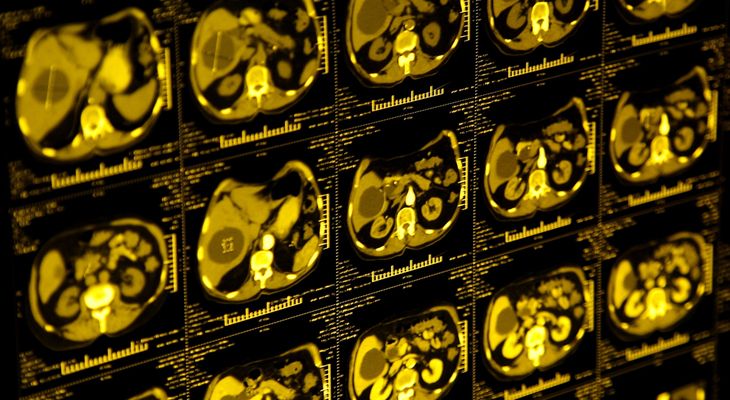Expert Guidance: During COVID-19, Lung Cancer CT Screenings Can Be Postponed
21-expert panel outlined 12 recommendations for when you can delay lung cancer screenings and lung nodule evaluations.

Much attention has been given during the COVID-19 pandemic to postponing screening services, largely focusing on breast imaging. However, lung cancer screenings also fall into this category and should be delayed in an effort to protect patients and conserve valuable medical sources, according to new guidance from an international expert panel.
Published in the Journal of the American College of Radiology, a group of 21 pulmonologists, thoracic radiologists, and thoracic surgeons drafted a consensus statement on the management of lung nodules and lung cancer screenings during the pandemic.
“There was a consensus that during the COVID-19 pandemic it is appropriate to defer enrollment in lung cancer screening and modify the evaluation of lung nodules due to the added risks from potential exposure and the need for resource allocation,” wrote the panel, led by Peter Mazzone, M.D., MPH, director of the Cleveland Clinic Lung Cancer Program and Lung Cancer Screening Program for the Respiratory Institute. “There are multiple local, regional, and patient related factors that should be considered when applying these statements to individual patient care.”
The consensus statement was created in accordance with current COVID-19 guidance from the Centers for Disease Control & Prevention, and it touches on how providers should handle CT lung cancer screenings, as well as the management of patients who have lung nodules during this outbreak. The guidance also appeared concurrently on April 24 in CHEST and Radiology: Imaging Cancer.
Based on two video conferences, the panel compiled 12 recommendations that fall under four areas. Each recommendation achieved at least 70-percent agreement among the panelists.
Baseline and Annual Lung Cancer Screening
- Defer initiation of lung cancer screenings for referred patients.
- Delay annual screening for patients due for repeat annual chest CT screening exam (Lung-RADS 1 or 2).
Surveillance of a Previously Detected Lung Nodule
- Delay CT scan for surveillance of nodules of average <8 mm diameter for 3-to-6 months.
- Postpone surveillance CT scan of screening-detected lung nodule (Lung-RADS 3) for 3-6 months.
- Delay surveillance chest CT scan for a patient with an incidentally detected pure ground glass nodule of any size for 3-6 months.
- Delay surveillance chest CT scan for incidentally- (or screening-) detected part-solid lung nodule with the solid component 6-8 mm in diameter for 3-6 months.
- Postpone 3-month surveillance chest CT for a patient with an incidentally detected solid nodule ≥ 8 mm in average diameter or a Lung-RADS 4 screening-detected nodule with < 10 percent probability for malignancy for 3-6 months.
Evaluation of Intermediate and High-Risk Lung Nodules
- Delay, for 3-6 months, a chest CT to evaluate a patient with an incidentally detected solid nodule ≥ 8 mm in diameter (or a Lung-RADS 4 screening-detected lung nodule) with a probability of malignancy between 10-25 percent.
- Conduct a chest CT scan within 3-6 months to evaluate on incidentally- or screening-detected part-solid lung nodule with the solid component ≥ 8 mm in diameter.
- Evaluate with a PET/CT scan and/or non-surgical biopsy a patient in need of evaluation for an incidentally detected solid nodule ≥ 8mm in diameter (or Lung-RADS 4 screening-detected lung nodule) with an estimated malignancy between 65-85 percent malignancy.
- Proceed to a treatment decision, including surgical resection or stereotactic radiotherapy, for a patient with an incidentally detected solid nodule ≥ 8 mm in diameter (or Lung-RADS 4 screening-detected lung nodule) where the probability of malignancy is > 85 percent.
Management of Clinical Stage I Non-Small Cell Lung Cancer
- After assessing cancer size, growth rate, FDG/PET avidity of the primary tumor, patient values, and general patient health and fitness, treatment, including surgery, can be delayed when reasonable.
Although these recommendations fall in line with guidance from the CDC, the panel also encouraged providers to discuss the course of treatment with patients.
“Patient preferences should be taken into account in all of the scenarios, because individual patients are likely to differ in how they perceive the potential benefits and harms associated with delayed or modified evaluation and management,” they wrote. “This highlights the importance of communication about the rationale for decisions with our patients.”
Decisions should also be based, they said, upon the prevalence of COVID-19 in the community, availability of rapid testing, levels of resources, local policies, and the presence of other care environments less impacted by the virus.
Study with CT Data Suggests Women with PE Have More Than Triple the One-Year Mortality Rate than Men
April 3rd 2025After a multivariable assessment including age and comorbidities, women with pulmonary embolism (PE) had a 48 percent higher risk of one-year mortality than men with PE, according to a new study involving over 33,000 patients.
The Reading Room: Racial and Ethnic Minorities, Cancer Screenings, and COVID-19
November 3rd 2020In this podcast episode, Dr. Shalom Kalnicki, from Montefiore and Albert Einstein College of Medicine, discusses the disparities minority patients face with cancer screenings and what can be done to increase access during the pandemic.
Predicting Diabetes on CT Scans: What New Research Reveals with Pancreatic Imaging Biomarkers
March 25th 2025Attenuation-based biomarkers on computed tomography (CT) scans demonstrated a 93 percent interclass correlation coefficient (ICC) agreement across three pancreatic segmentation algorithms for predicting diabetes, according to a study involving over 9,700 patients.
Can Photon-Counting CT be an Alternative to MRI for Assessing Liver Fat Fraction?
March 21st 2025Photon-counting CT fat fraction evaluation offered a maximum sensitivity of 81 percent for detecting steatosis and had a 91 percent ICC agreement with MRI proton density fat fraction assessment, according to new prospective research.